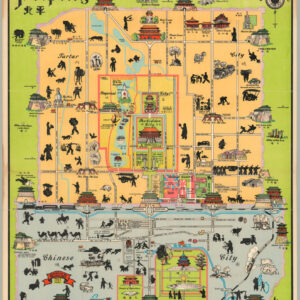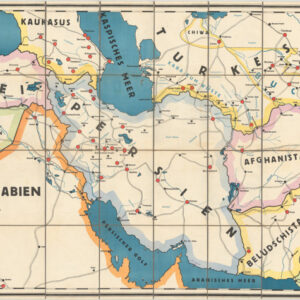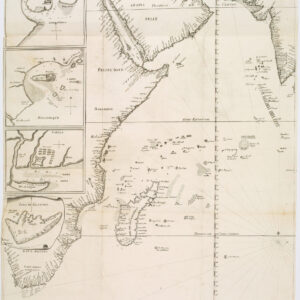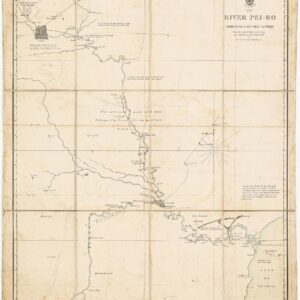Münster’s iconic map of Asia in original black & white: one of the earliest manifestations of the transition from Ptolemaic geography to modern cartography.
La table de la region orientale, comprenant les derniered terres & royraumes d’Asie.aumes d’Asie
$2,200
In stock
Description
Listen to team member Kristoffer talk about this map:
Sebastian Münster’s map of Asia is one of the first printed maps to challenge some key Ptolemaic conventions of the continent’s geography. Gone is the massive peninsula often referred to as Asia’s ‘Dragon Tail’; seen, for example, in this 1535 world map by Laurent Fries. Instead, we see an early attempt to adapt the Classical vision with more recent and contemporary observations by travelers, merchants, and explorers. The map essentially covers the entire Asian landmass, with both the Indian Ocean and Western Pacific depicted.
On first glance, the map appears relatively simplistic in its rendition, adhering to the schematic depiction of geographic space that was common in the 15th and early 16th centuries. It stretches from Moscow in the west to the coast of Cathay (China) in the east, and from the Arctic Ocean (Oceanus Hyperboreus) in the north to the Indian Subcontinent and Indonesian archipelago in the south. The land mass is equipped with stylized mountain ranges, rivers, and lakes. It depicts quadratic versions of both the Caspian Sea and Persian Gulf; both hallmarks of a traditional Ptolemaic world view. There are quite a few place names printed on the map, but this is of course nothing when considering what an enormous expanse this actually was. Among the recognizable places we find regional toponyms such as India, Cathay, Parthia, and Arabia. We also find a number of important ports of trade, some of which were ancient and indigenous (e.g. Aden and Cambaya/Khambhat), while others that were predominantly colonial (e.g. Goa).
Oddities, myths, and innovations
The map also contains an array of strange attributions, as well as a plethora of new ideas and fresh information. When it comes to odd place names or the misplacing of relatively established entities, we might note that what today is the Chutkotka Ukrug (northeast Russia) is labeled India Superior on Münster’s map. This is not without significance, as it constitutes a reference to some of the earliest notions of a Northwest Passage known from printed maps. The goal behind this idea was always to secure an alternative route for the India trade, thus providing an explanatory framework for this toponym. Other oddities include the division of Java into two islands and the labeling of these as Java Maior and Java Minor, or the positioning of Zanzibar southeast of Madagascar, in the southern Indian Ocean.
When it comes to significant innovations, a fine example is found in the Pacific, which has been supplied by numerous islands and a label informing us that this depiction in fact represents an enormous archipelago with no less than 7448 islands. While most people today are well aware of the fact that the Pacific is filled with small and large islands, both in clusters and on their own, in the early to mid 16th century, this was far from common knowledge. The original state of this map was printed around 1540, several years before the first European ships arrived in Japan (the relevance of which we shall come back to). Münster, therefore, was forced to draw on a much earlier source: the 14th century reports of Marco Polo. One might question why Japan is brought up, when it is not even depicted on the map. But this highlights another critical feature of this map. While cartographers like Münster continued to be heavily influenced by the Ptolemaic conception of the world, they were seeking to align these concepts with the many reports coming back from people who had actually been there. Initially, the way this revisionist approach manifested itself was by including new and updated Tabulas that would render either updated versions of continents or entirely new land masses, such as the Americas.
Münster’s Asia map is ultimately conceived as part of a greater whole. This becomes apparent when the Asia map is laid next to the America map from the same volume of Münster’s Cosmographia. In unison, these maps do not just show the continents, but become one of the first printed maps of the Pacific Ocean in its entirety. It also solves the issue of Japan’s omission from the Asia map, as Münster pushed its location so far west that it actually ends up on the America map.

Unusual sea creatures
A final aspect worth noting are the decorative elements contained in this map. These are not only characteristic of this pivotal period in European cartography, but they also encapsulate how little we knew about the world, and give us an idea about just how frightening venturing into the unknown must have been. At the bottom of the map we find an example of the type of large sea monster often seen on 16th century maps. Enormous fish or whales were common features in Münster’s maps as well, and indeed we find many classic specimen from his bestiary repertoire. A more enigmatic and rare figure is found in the lower right of the map. The ichthyocentaur is half human and half sea creature. Ortelius famously depicts one in his 1590 map of Iceland, but that is almost three decades after Münster printed this map. Moreover, where Ortelius and others usually depicted the human part as a bearded man (much like the centaurs of Greek mythology), Münster opted for a child-like figure with a double tail. This constitutes a very early representation of the ichthyocentaur in this form. The tradition of depicting morphed creatures on maps can nevertheless be traced back to manuscript maps from the mid-15th century, where mermen would often figure prominently.
Conclusion
In sum, this fantastic wood block print constitutes one of the most informed, yet early views of Asia. It was produced in a time that was characterized not only by constantly expanding geographic frontiers, but also by a vivacious imagination and a deeply rooted mythology. It merges the classical traditions of Ptolemaic mapping with the new realities of the 16th century – for example by linking the Asia and America maps to create a new mapped space in the Pacific. It is as such a true product of the Renaissance from the hands of one of the most important cartographers of this decisive century.
Cartographer(s):
Sebastian Münster (1488-1552) was a cosmographer and professor of Hebrew who taught at Tübingen, Heidelberg, and Basel. He settled in Basel in 1529 and died there, of the plague, in 1552. Münster was a networking specialist and stood at the center of a large network of scholars from whom he obtained geographic descriptions, maps, and directions.
As a young man, Münster joined the Franciscan order, in which he became a priest. He studied geography at Tübingen, graduating in 1518. Shortly thereafter, he moved to Basel for the first time, where he published a Hebrew grammar, one of the first books in Hebrew published in Germany. In 1521, Münster moved to Heidelberg, where he continued to publish Hebrew texts and the first German books in Aramaic. After converting to Protestantism in 1529, he took over the chair of Hebrew at Basel, where he published his main Hebrew work, a two-volume Old Testament with a Latin translation.
Münster published his first known map, a map of Germany, in 1525. Three years later, he released a treatise on sundials. But it would not be until 1540 that he published his first cartographic tour de force: the Geographia universalis vetus et nova, an updated edition of Ptolemy’s Geography. In addition to the Ptolemaic maps, Münster added 21 modern maps. Among Münster’s innovations was the inclusion of map for each continent, a concept that would influence Abraham Ortelius and other early atlas makers in the decades to come. The Geographia was reprinted in 1542, 1545, and 1552.
Münster’s masterpiece was nevertheless his Cosmographia universalis. First published in 1544, the book was reissued in at least 35 editions by 1628. It was the first German-language description of the world and contained 471 woodcuts and 26 maps over six volumes. The Cosmographia was widely used in the sixteenth and seventeenth centuries and many of its maps were adopted and modified over time, making Münster an influential cornerstone of geographical thought for generations.
Condition Description
Very good; minor wear along the top margin and centerfold.
References



